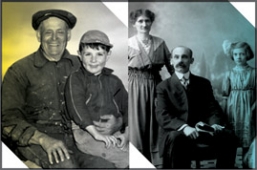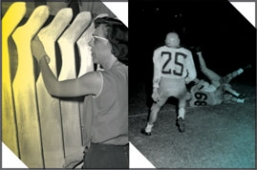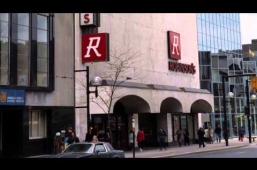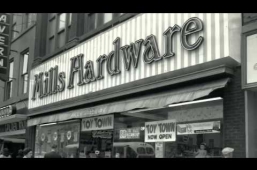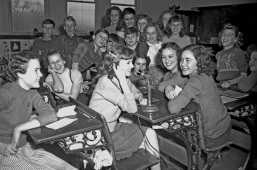November of 1906 saw Hamilton in the midst of one of the most violent strikes in its history. A dispute had arisen between the Cataract Power, Light and Traction Company and its employees at the Hamilton Street Railway. On November 5, 1906 a strike was called. The general manager of the company was determined that the streetcars would run and the strikers were equally determined that they would not. There was property damage done to the car barns and the photograph below shows the result of rocks being thrown through the office windows of the company building.
There was a sharp increase in hooliganism and hurling rocks at streetcars became a popular sport. Although many of those who supported the strike by wearing their blue "We Walk" buttons were peaceful the rowdy element saw the strike as an excuse for lawlessness and were seen as a serious threat. The Police Chief Smith told Mayor Biggar that his department was unable to protect the public or private property. At the request of the Mayor regular troops were sent from Toronto's Stanley Barracks to Hamilton. They arrived on Wednesday, November 21st.
The force consisted of mounted men of the Royal Canadian Horse Artillery, the Royal Canadian Dragoons and infantry of the Royal Canadian Regiment. The next day more troops arrived from London bringing the total to 15 officers and 162 men. Friday night of that week saw the worst outbreak since the beginning of the strike. Any streetcars running were met with a hail of missiles until 9 p.m. when they were all taken off the streets. A detective attempting to make an arrest after a store window was smashed was beaten to his knees. The officer who went to his assistance was forced to draw his revolver to hold off the mob. At 7:15 p.m. on Saturday, November 24, 1906, Mayor Biggar appeared at the front door of City Hall to face a mob. They were held in check by police and soldiers. Sheriff Middleton, in formal dress was standing beside the Mayor. Then, for the first time in Hamilton's living memory, the Sheriff read the Riot Act.
"Scarcely had "God Save the King" concluded the formality than police and soldiers went in with clubs swinging and with fixed bayonets - and the huge mass dissolved in flight. Cavalry rode on the sidewalks, driving the crowds before them, and as usual the innocent bystander bore much of the brunt. Citizens were pursued into stores, men staggered along with bleeding faces. One Benjamin Kerr was clubbed as he sat on his piano stool in a restaurant. Jones Lewis, on his way to work at the Hamilton Herald, was pursued even into the editorial sanctum. A patient leaving Dr. Roseburgh's, at King and Hunter, suffered a broken head and was soon back for medical attention.
Rescued from a patrol wagon, a rioter was hit by a stone that ricocheted from the helmet of Police Sgt. Knox. Constables Hallisey, and John Bleakley were seriously injured by bricks and an old lady connected with a club when she sought shelter in the Times office on Hughson and King William. Hans Hansen, on his way to work, was felled by a blow and getting up was knocked down by another. A citizen dragged his injured wife up the City Hall steps to protest to the Mayor. Infantry with bayonets chased people up and down. Charles Dodsworth, of the Henry Irving company, on his way to play at the Grand was chased for blocks and then injured. Many stores suffered damage - the People's Furniture, Chadwick Bros., J. Truman and Co., McPhails and J.O. Hopes. The riot kept up for hours. Never had there been such a night in this city's annals.
As a result much popular sympathy swung to the strikers. A few days later a settlement was reached - and in December some rioters were sentenced. The great car strike left an aftermath of bitterness which only time could efface." (Hamilton Spectator, November 18, 1963, pg. 26)















